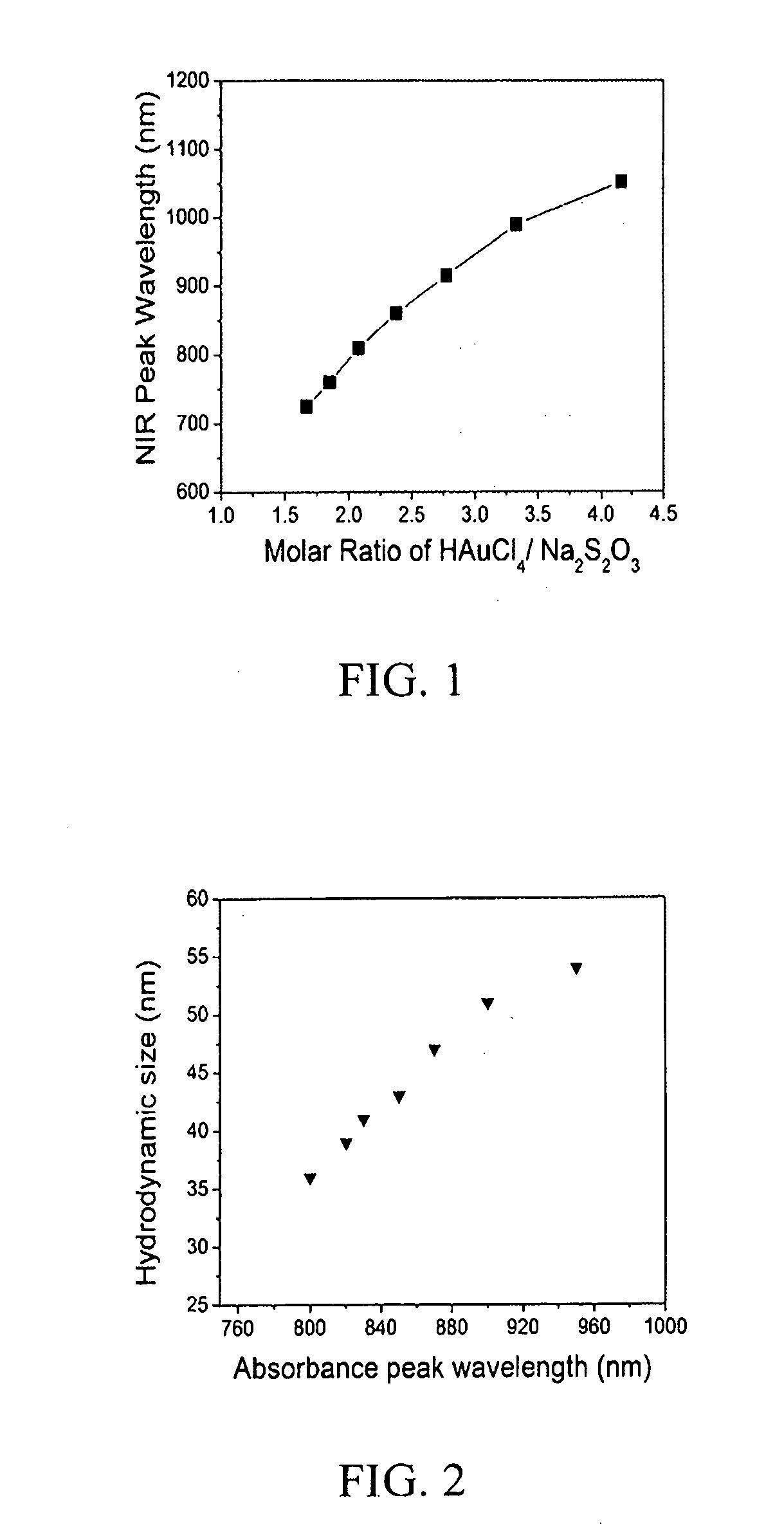Diagnostic and therapeutic nanoparticles
a technology of nanoparticles and diagnostics, applied in the direction of antibody medical ingredients, peptide/protein ingredients, drug compositions, etc., can solve the problems of increasing the chance of death, high mortality rate of cancers after metastasis, and high risk of health effects, so as to improve the diagnosis of these conditions.
- Summary
- Abstract
- Description
- Claims
- Application Information
AI Technical Summary
Benefits of technology
Problems solved by technology
Method used
Image
Examples
example 1
[0044]This example demonstrates the preparation of a first embodiment of the hybrid nanoparticle of the present invention. This hybrid nanoparticle includes a GGS nanoparticle with an absorbance peak at about 820 nm and a chitosan coating and has an isoelectric point of about 7.7. The procedure to prepare this embodiment of the present invention is as follows.
[0045]GGS nanoparticles are prepared by the reaction of sodium thiosulfate and chloroauric acid. 54 ml 3 mM Na2S2O3 is HAuCl4, and vortexed for about 1 minute. The solution is then left to react for about 45 minutes. The nanoparticle concentration is around 3.5 to 4 OD.
[0046]Low molecular weight (“LMW”) chitosan, such as that provided by Sigma-Aldrich, is used for the coating of GGS nanoparticles. The chitosan solution is prepared by dissolving 1.0 g LMW chitosan in 100 ml 0.7 wt. % acetic acid solution.
[0047]The chitosan is added to the GGS nanoparticle solution about 45 minutes after the mixing of chloroauric acid and sodium ...
example 2
[0050]This example demonstrates the preparation of a second embodiment of the hybrid nanoparticle of the present invention. This hybrid nanoparticle includes a GGS nanoparticle with an absorbance peak at about 820 nm and a TIBA-modified chitosan coating and has an isoelectric point of about 7.7. The procedure to prepare this embodiment of the present invention is as follows.
[0051]GGS nanoparticles are prepared by the reaction of sodium thiosulfate and chloroauric acid. 54 ml 3 mM Na2S2O3 is added to 150 ml 2 mM HAuCl4, and vortexed for about 1 minute. The solution is then left to react for about 45 minutes. The nanoparticle concentration is around 3.5 to 4 OD.
[0052]TIBA-modified chitosan is used for the coating of GGS nanoparticles. The TIBA-modified chitosan solution is prepared by dissolving 0.4 g LMW chitosan in 40 ml 0.7 wt. % acetic acid solution. The chitosan solution is then dialysed in DI water for 2 to 6 days. The pH of the chitosan solution increases from about 4.0 to abou...
example 3
[0056]This example demonstrates the preparation of a third embodiment of the hybrid nanoparticle of the present invention. This hybrid nanoparticle includes a GGS nanoparticle with an absorbance peak at about 850 nm and a blended chitosan / CMCS coating and has an isoelectric point of about 7.1. The procedure to prepare this embodiment of the present invention is as follows.
[0057]GGS nanoparticles are prepared by the reaction of sodium thiosulfate and chloroauric acid. 28.5 ml 3 mM Na2S2O3 is added to 150 ml 2 mM HAuCl4, and vortexed for about 1 minute. The solution is then left to react for about 45 minutes. The nanoparticle concentration is around 3.5 to 4 OD.
[0058]A blend of LMW chitosan and CMCS is used for the coating of GGS nanoparticles. The chitosan solution is prepared by dissolving 1.0 g LMW chitosan in 100 ml 0.7 wt. % acetic acid solution. CMCS is prepared by dissolving 15 g sodium hydroxide in a mixture solution of 80 ml isopropanol and 20 ml DI water. 10 g LMW chitosan i...
PUM
| Property | Measurement | Unit |
|---|---|---|
| diameters | aaaaa | aaaaa |
| density | aaaaa | aaaaa |
| density | aaaaa | aaaaa |
Abstract
Description
Claims
Application Information
 Login to View More
Login to View More - R&D
- Intellectual Property
- Life Sciences
- Materials
- Tech Scout
- Unparalleled Data Quality
- Higher Quality Content
- 60% Fewer Hallucinations
Browse by: Latest US Patents, China's latest patents, Technical Efficacy Thesaurus, Application Domain, Technology Topic, Popular Technical Reports.
© 2025 PatSnap. All rights reserved.Legal|Privacy policy|Modern Slavery Act Transparency Statement|Sitemap|About US| Contact US: help@patsnap.com

